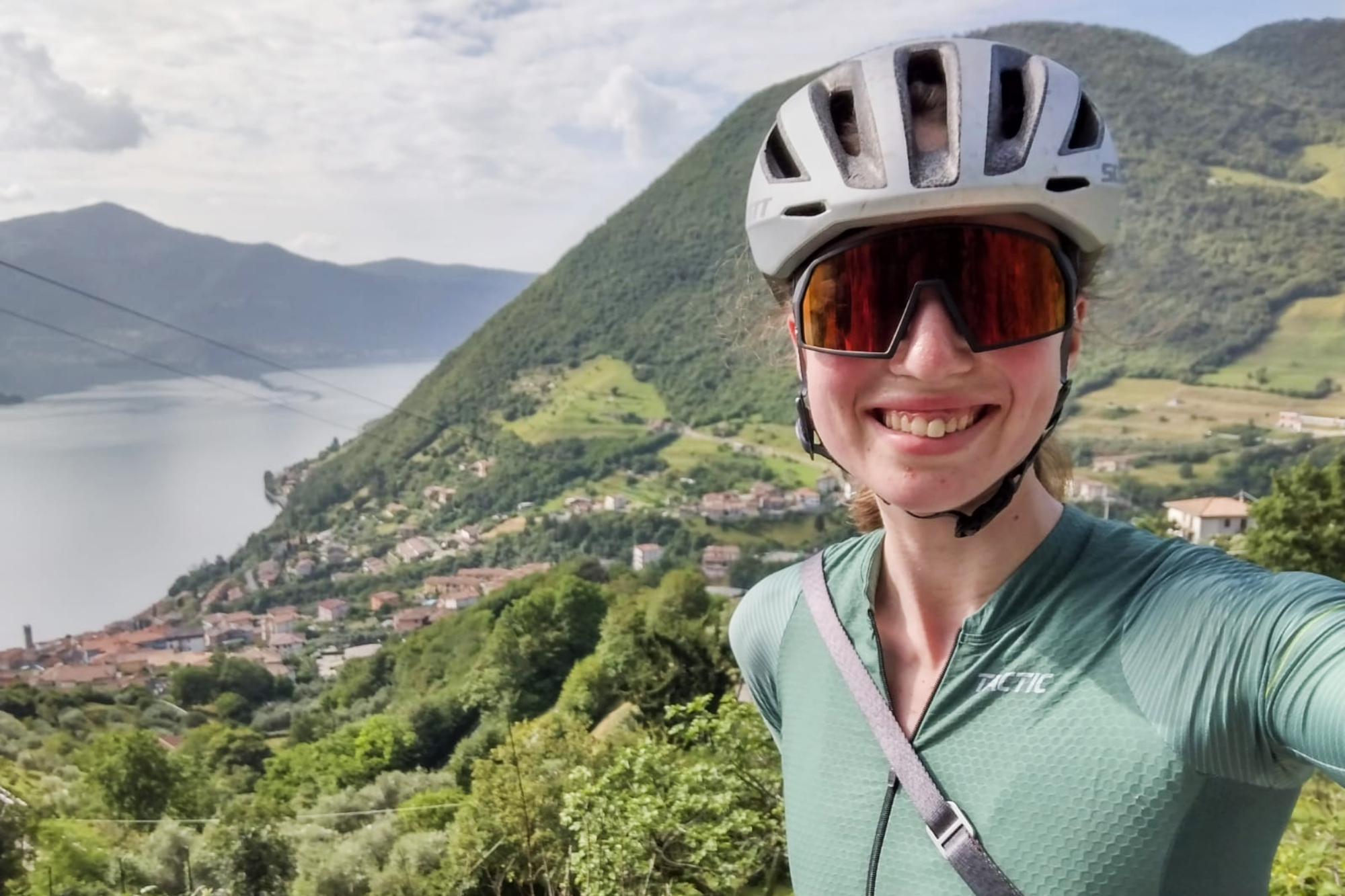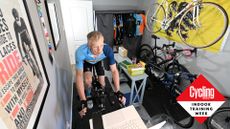How to challenge yourself on Zwift without entering a race
Building up to more demanding routes, setting PBs up the Alpe du Zwift, hunting out the in-game segments – there are so many ways to push yourself without taking to the virtual start-line


There is just so much more to Zwift than simply working your way through set workouts or burying yourself in a race –although these do have their own draw. Routes, segments and pace partners are all at your disposal and can be excellent ways of staying interested and returning to the platform regularly to make gains and track your progress.
With these challenges you aren’t tied to specific times, just rock up in the virtual world whenever you want all year round, test yourself, and repeat. You don’t have to worry about any other uncontrolled variables getting in the way, you can simply jump on your turbo trainer or smart bike and get on with your session.
So, without any further ado, let’s see what else the world’s most popular indoor cycling app has to offer – aside from the racing.
Complete Zwift’s impressive catalogue of routes

Zwift has nine different worlds to explore and within each of these are plenty of routes to take on - currently 112 of these earn you a special achievement badge. Admittedly, some are event-only routes, but most are just free to ride whenever you want.
With so many courses, there’s a lot of scope for gradually upping the distance of the rides you tackle. Just make sure to pay attention to the amount of elevation the route is packing - it might be the same distance as a course you’ve just completed, but you could find yourself spending a lot more time in the saddle.
Increasing your total volume slowly is important so as not to beset yourself with an overuse injury. ABCC Level Cycling Coach Jonathan Melville of Breakaway Coaching and Analytics recommends increasing by no more than 10% for beginners and 15% per week for more experienced riders.
“If you’re a beginner you’ll be making a lot of gains in the first month but sustaining that same level of gain can be quite difficult, so think of it in the long run, making slow improvements each month,” Melville advises.
So if you are looking to build your endurance, and train for your first 100-mile ride for example, completing these routes can be a motivating way of increasing your mileage and time on the bike. And then returning the following week - as you’ll have another to tick off for a long while to come.

Completing one of these routes can be part of your longer Zone 2 endurance ride (3-4 hours at 55-75% FTP) each week, as detailed in this training plan for building up to 100 miles. If you’re unsure what your FTP and power zones are you can check out our guide to setting up your training zones here.
As well as using the routes for regular training, if you don’t have a real-world sportive event on your calendar, one of the longer routes could be used as your end goal, the target of your cycling training plan.
The longest route on Zwift is the PRL Full in London at 173km long and it’s not flat either, it packs in 2496m. Other challenging ones include The 107km long Mega Pretzel with 1642m of climbing and the 128.3km long Uber Pretzel at 128.3km with 2335m.
Attack the sprint and climb segments

In addition to Strava segments, Zwift has its own in-game timed sections that you can use to track your fitness progress by beating your own times - and also allowing you to see how you stack up against others that are riding on the platform. Or, at least, those on the platform at a similar time to you - the leaderboard shows your overall out of everyone online for the last hour and there’s a women’s specific ranking leaderboard too.
Across the worlds and the courses, Zwift has sprint and climb segments within each and all of varying lengths and difficulties.
The sprint segments are around 200m and 400m, and are typically flat. The Achterbahn route in Innsbruck, for example, has a 200m and 300m segment.
Climbs vary from the short and steep, to the long and shallow, to the long and still fairly meaty.
If you take the Four Horsemen route in Watopia, for example, there’s the Volcano KOM/ Volcano QOM which is 3.75km at an average gradient of 3.2% and the much longer and steeper Alpe du Zwift at 12.44km with a taxing 8.5% average gradient.
The climb segments can be a lot shorter and sharper too, though. The 23rd St climb in Richmond is 10% but only for 0.28km. You can find this one by following the 2015 UCI Worlds course.
“The segment aspect of Zwift allows you to focus in on specific areas of your cycling fitness and make improvements that way,” Melville notes.
“Choose a segment to test yourself on, then in four to eight weeks time retest on that same segment to determine if you’ve made any improvements.”
For each segment Zwift shows a list of your 30 day PRs so if you’re looking to put in another attempt at the longer end of Melville’s recommendation make sure you’ve made a note of your time off the platform - basically, don’t rely on Zwift for this data for longer term fitness tracking.

Zwift isn’t your local lanes, which may be pan flat for miles or frustratingly hilly all around. It’s easy to find a segment that is in line with the effort you’re looking to target. Also, you don’t have to worry about other factors such as traffic or the weather preventing you from executing the effort on the day.
If you’re looking for a truly accurate PB, it’s best to select a TT bike as this prevents your in-Zwift avatar from drafting off other riders. If you just ride a standard bike you’re likely to get a faster time, which sounds great, but it’s likely to be harder to replicate - it all depends on the riders around you and that’s not a useful way of tracking improvements.
The only other thing to be aware of is that the worlds are on rotation and so not always open for riding. Zwift does have a colour-coded calendar, showing which worlds are open in the upcoming month. Watopia is always available though, so focusing on segments that suit your targets there - and there are plenty to get stuck into - will allow you to keep on coming back for more.

“One of the potential downsides with Zwift is that it can be hard to do low intensity training because of the segments,” Melville warns. Be sure not to treat the glowing start lines as a red flag to a bull - it’s fine to just roll through if that’s what your session requires.
Work off a pace partner

Looking to challenge yourself to riding at a sustained pace? “Pace partners are great for beginners or even advanced riders looking to feel what high power output feels like,” Melville notes. Pace Partners are not real riders so they are guaranteed to ride at a consistent pace, and unlike group rides, they are always around to join.
“If you’re trying to ride at a higher intensity that you’re less familiar with, like an anaerobic effort, you could use the pace partner as a tight rope to understand what that intensity feels like for a prolonged period,” Melville suggests.
Another fun challenge is to attack off the front of the pace partner group and then settle back into the pace of the group - and repeat. This will improve your ability to recover while still sustaining an effort, which is important for races and ‘spirited’ rides with your mates.
Just don’t do this in Zwift’s group rides, though, as it disrupts others and the intention of the ride. But pace partners are bots, so they won’t mind.
As an aside, if you are struggling with your discipline to keep the intensity low, Melville recommends choosing a pace partner with a low w/kg to help you understand what a low intensity effort feels like.
What other challenges are there on Zwift?
In addition to the route achievement, watt and distance badges, Zwift has three challenges: Climb Mt. Everest, Ride California and Tour Italy.
These challenges are essentially awarded by commitment to the platform, by regularly showing up and riding.
The Climb Mt. Everest challenge is achieved by climbing 8,850 metres and so those who don’t shy away from the hillier routes are going to work towards this challenge a lot quicker than those you find they always choose a flatter course. Plus, if you keep on going to 50,000, you’ll unlock the ‘Tron bike’.

Thank you for reading 20 articles this month* Join now for unlimited access
Enjoy your first month for just £1 / $1 / €1
*Read 5 free articles per month without a subscription

Join now for unlimited access
Try first month for just £1 / $1 / €1
Get The Leadout Newsletter
The latest race content, interviews, features, reviews and expert buying guides, direct to your inbox!

I’ve been hooked on bikes ever since the age of 12 and my first lap of the Hillingdon Cycle Circuit in the bright yellow kit of the Hillingdon Slipstreamers. For a time, my cycling life centred around racing road and track.
But that’s since broadened to include multiday two-wheeled, one-sleeping-bag adventures over whatever terrain I happen to meet - with a two-week bikepacking trip from Budapest into the mountains of Slovakia being just the latest.
I still enjoy lining up on a start line, though, racing the British Gravel Championships and finding myself on the podium at the enduro-style gravel event, Gritfest in 2022.
Height: 177cm
Weight: 60–63kg
-
 In search of the world's best club jersey: Jubilee Park CC v Kibworth Velo Club
In search of the world's best club jersey: Jubilee Park CC v Kibworth Velo ClubEvery week we pit two club kits against each other and you get to vote on the best designs
By James Shrubsall Published
-
 'I had to wait at the top of every hill' – the highs and lows of Malcolm Elliott's career in the fast lane
'I had to wait at the top of every hill' – the highs and lows of Malcolm Elliott's career in the fast laneThroughout his two-part career, no-one epitomised Sheffield steel like Cycling Weekly's 2023 Lifetime Achievement award winner Malcolm Elliott
By James Shrubsall Published
-
 My best winter ever: Why I shaved my legs for my first Zwift race
My best winter ever: Why I shaved my legs for my first Zwift raceAfter a month of hard training, it’s finally race day. Can I win the 10-mile time trial?
By Tom Davidson Published
-
 My best winter ever: My new coach is a three-time Olympic champion - I’m guaranteed to win my first Zwift race
My best winter ever: My new coach is a three-time Olympic champion - I’m guaranteed to win my first Zwift raceThere have been ups and downs in my training for the 10-mile time trial. It turns out I groan when I dig deep
By Tom Davidson Published
-
 'The Earth’s circumference is 40,075km and I went over 45,000km': Meet the cyclists riding the furthest and the longest from the comfort of their homes
'The Earth’s circumference is 40,075km and I went over 45,000km': Meet the cyclists riding the furthest and the longest from the comfort of their homesIn search of indoor riders who go beyond the bounds of accepted norms, Steve Shrubsall tracks down a cast of characters who leave blood, sweat and traces of their soul on the turbo trainer
By Stephen Shrubsall Published
-
 Real-world success: top-ranked Zwifter crushes first 'real' bike races
Real-world success: top-ranked Zwifter crushes first 'real' bike races"Outside always felt like this unicorn, something mystical or magical that I couldn’t do," says American Esports elite Kristen Kulchinsky
By Christopher Schwenker Published
-
 Nine things I wish I knew when I started indoor cycling...
Nine things I wish I knew when I started indoor cycling...And yes, the surprising extent to which human sweat can corrode a headset is there at number six
By Sam Gupta Published
-
 Are your indoor and outdoor rides working against each other?
Are your indoor and outdoor rides working against each other?Here’s how to successfully combine your indoor and outdoor rides for maximum fitness gains
By Deena Blacking Published
-
 Ask a coach: ‘I'm over 50, are there any indoor workouts I should avoid?’
Ask a coach: ‘I'm over 50, are there any indoor workouts I should avoid?’Here’s how you can get the most from indoor training as you get older
By Alex Welburn Published
-
 Zwift’s new Hub One smart trainer ditches the cassette for compatibility with 'almost any 8-12 speed bike'
Zwift’s new Hub One smart trainer ditches the cassette for compatibility with 'almost any 8-12 speed bike'The Hub One offers ‘virtual shifting’ similar to a smart bike - with the resistance changes handled internally, there’s no reason for more than one sprocket
By Anna Marie Abram Published









